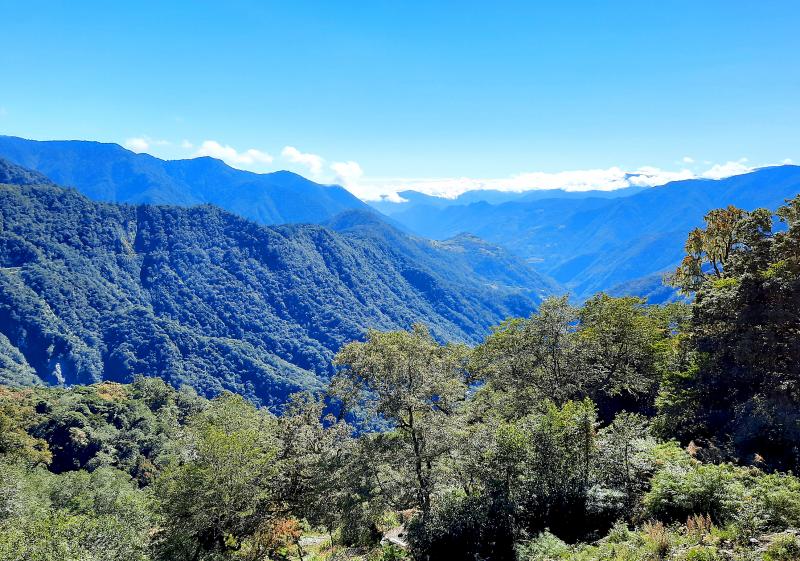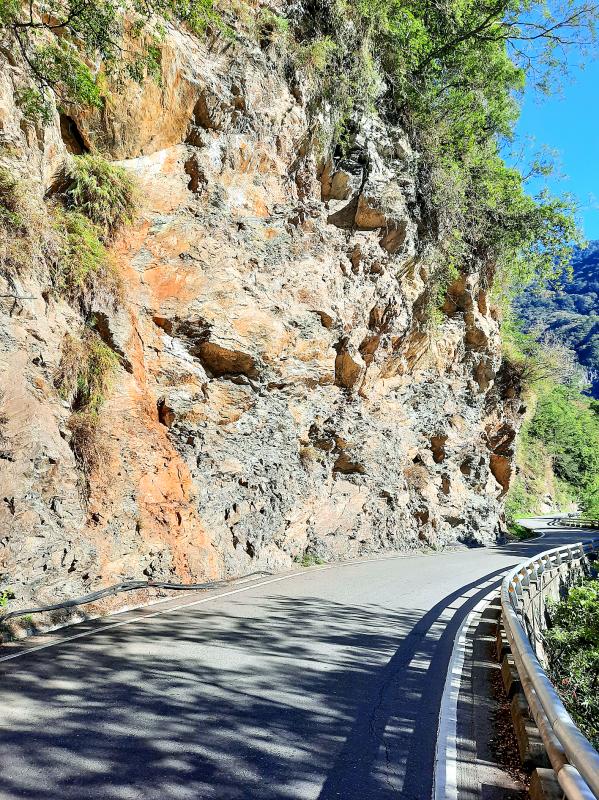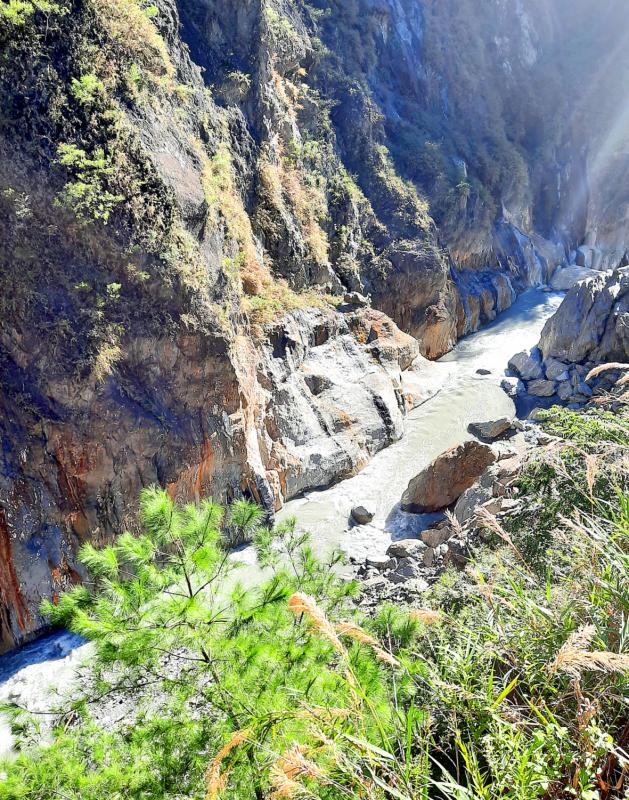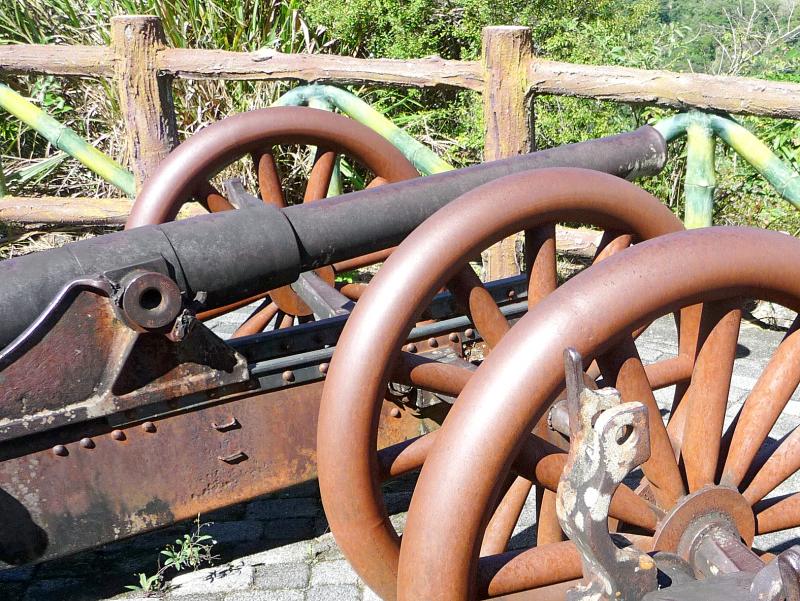On the day I rode a 125cc two-wheeler to 2,312m above sea level, the northwestern corner of Taitung County wasn’t merely beautiful. It was “renounce all worldly possessions and walk out on your family, if that means you can stay” sublime.
At first light in Chihshang (池上), I rode through jacket-dampening fog. Outside the town, I escaped the morning mists, and zipped inland on an empty road.
In the space of just under 6km, Provincial Highway 20A (20甲) exits Chihshang, passes farms, crosses the Sinwulu River (新武呂溪), and merges into Provincial Highway 20. The latter road is also known as the South Cross-Island Highway (南橫公路).

Photo: Steven Crook
Turning right onto Highway 20, I spotted the 199km marker and a traffic sign that pointed to Tainan, 204km away and on the other side of the Central Mountain Range. That sign predates Typhoon Morakot, a once-in-a-lifetime storm that wrought disaster across the south in the summer of 2009.
Since Morakot, the high-altitude section of the South Cross-Island Highway has been officially closed to through-traffic. In the first year or two after the typhoon, a handful of brave motorists got their vehicles all the way across, but further landslides occurred around 2012. These didn’t deter outdoors types, several of whom risked fines by evading the checkpoint outside Meishankou (梅山口) in Kaohsiung’s Taoyuan District (桃源). Some hiked to Taitung County; a few rode bicycles.
I’m a law-abiding person, so I didn’t return to the stretch of Highway 20 between Meishankou and Tianchih (天池) — also on the Kaohsiung side, but higher in the Central Mountain Range — before it’s formal reopening to sightseers in January this year (see “Ascending to ‘heaven’s pond’” in the Feb. 21, Taipei Times). Between Morakot and last week, I didn’t once set foot or tire on the road’s eastern half.

Photo: Steven Crook
The Ministry of Transportation and Communications has said it aims to have the entire South Cross-Island Highway open to the general public before the end of next year.
Opposite the police station that monitors the intersection between highways 20A and 20, a bilingual notice reminds road-users: “Access to Siangyang (向陽) only.” The distance from central Chihshang to Siangyang is approximately 57km. Even allowing for the steep gradients and tight corners I’d need to negotiate slowly, I expected to have plenty of time to enjoy the landscape, and still complete the roundtrip before dusk.
I halted very briefly at the Fengban Monument to Anti-Japanese Resistance (逢?抗日紀念碑), which celebrates Bunun Aboriginal clans who pushed back against oppressive colonial rule in 1919, and not at all at Sinwu (新武), where a sign told me I was 412m above sea level.

Photo: Steven Crook
Around the 192.5km marker, I stopped to look at a spot where I camped a couple of times, long before gravel washed down by Morakot raised the riverbed. Turning my attention to the south side of the road, I saw an information board introducing the Guanshan Formosan Date Palm Reserve (關山台灣海棗自然保護區).
Like many other species, the Formosan date palm has suffered from deforestation and development. Around 2,200 specimens survive in this 54-hectare conservation zone, which was established in 1970. I was tempted by the footpath leading into the reserve, but the minimum fine for unauthorized entry is NT$50,000.
On every previous trip through Wulu Gorge (霧鹿峽谷), I was on a bus or hitching lifts. This time, I could stop wherever and whenever I wanted, and give this geological marvel the attention it deserves. Between the 184km marker and the 181km marker, the scenery is almost as good as Taroko Gorge, with far fewer cars and people.

Photo: Steven Crook
In several places, sulfurous water has stained the cliffs. If you’d like to soak your feet in a hot spring, the best place to do it is by the 179km marker, where there’s a free-of-charge, government-maintained outdoors footbath.
Pushing on, I passed the plateau which hosts the Bunun settlement of Lidao (利稻; altitude 1,068m). From there, Highway 20 switchbacks up to Motian (摩天; 1,546m above sea level), where there’s no permanent village.
Motian has hardly any trees — the slopes were cleared and terraced long ago so cabbages could be cultivated — but the rest of the ride took me through alluring temperate woodlands. Liyuan (栗園), near the 159km marker, is 1,793m above sea level. Almost 10km further on, I came to a sign that announced my arrival at Siangyang. It listed the altitude as 2,312m.
The entrance to Siangyang National Forest Recreation Area (向陽國家森林遊樂區) was right around the corner. Just beyond it, next to the 149km marker, a rope across the asphalt signaled the end of legally accessible highway. When I asked a workman if I might walk a short way beyond to take some photos, his refusal was friendly but emphatic.
Siangyang National Forest Recreation Area is temporarily closed to visitors while its facilities are renovated, so there wasn’t much reason to hang around.
For parts of the descent, I freewheeled downhill, and not just to save gas and reduce carbon emissions. The quieter I moved, the greater my chances of seeing some wildlife. However, the only interesting non-humans I sighted were a pair of Mikado pheasants and a single macaque, all near Wulu Gorge.
I had vague recollections of Wulu (霧鹿) being a more attractive village than Lidao, so when I saw the sign for Wulu Fort Memorial Park (霧鹿砲台紀念公園) near the 186km marker, I made a detour. Finding the park, which is 1.8km from the highway, might not be easy if you can’t read any Chinese; only the sign on the main road is bilingual.
The term “fort” is misleading. During the years-long, low-intensity conflict between the Japanese and the Bunun, the colonial power placed two artillery pieces atop this hillock, almost 900m above sea level, so they could bombard uncooperative Aborigines. But there wasn’t much actual fortification, it seems.
The weapons, which the Japanese captured from the Russians during the Russo-Japanese War of 1904-1905, are still here. Both have calibers of about 60mm, but they’re not identical. The on-site information panel doesn’t say if, after the Japanese installed the guns here in 1927, they fired shells they’d captured with the artillery pieces, or if they were manufacturing their own.
The Chinese-style concrete pavilion that now decorates this spot is incongruous. Rather than sit on one of its benches, I used my time trying to get a decent photo bringing together the Central Mountain Range and the artillery pieces that colonial forces had pointed at the area’s indigenous inhabitants. That, I figured, would neatly sum up the history and geography of this glorious region.
Steven Crook has been writing about travel, culture and business in Taiwan since 1996. He is the author of Taiwan: The Bradt Travel Guide and co-author of A Culinary History of Taipei: Beyond Pork and Ponlai.

Anyone who has been to Alishan (阿里山) is familiar with the railroad there: one line comes up from Chiayi City past the sacred tree site, while another line goes up to the sunrise viewing platform at Zhushan (祝山). Of course, as a center of logging operations for over 60 years, Alishan did have more rail lines in the past. Are any of these still around? Are they easily accessible? Are they worth visiting? The answer to all three of these questions is emphatically: Yes! One of these lines ran from Alishan all the way up to the base of Jade Mountain. Its

The only geopolitical certainty is that massive change is coming. Three macro trends are only just starting to accelerate, forming a very disruptive background to an already unsettled future. One is that technological transformations exponentially more consequential and rapid than anything prior are in their infancy, and will play out like several simultaneous industrial revolutions. ROBOT REVOLUTION It is still early days, but impacts are starting to be felt. Just yesterday, this line appeared in an article: “To meet demands at Foxconn, factory planners are building physical AI-powered robotic factories with Omniverse and NVIDIA AI.” In other words, they used AI

Last month historian Stephen Wertheim of the Carnegie Endowment for International Peace published an opinion piece in the New York Times with suggestions for an “America First” foreign policy for Democratic presidential candidate Kamala Harris. Of course China and Taiwan received a mention. “Under presidents Trump and Biden,” Wertheim contends, “the world’s top two powers have descended into open rivalry, with tensions over Taiwan coming to the fore.” After complaining that Washington is militarizing the Taiwan issue, he argues that “In truth, Beijing has long proved willing to tolerate the island’s self-rule so long as Taiwan does not declare independence

Nov. 25 to Dec. 1 The Dutch had a choice: join the indigenous Siraya of Sinkan Village (in today’s Tainan) on a headhunting mission or risk losing them as believers. Missionaries George Candidus and Robert Junius relayed their request to the Dutch governor, emphasizing that if they aided the Sinkan, the news would spread and more local inhabitants would be willing to embrace Christianity. Led by Nicolaes Couckebacker, chief factor of the trading post in Formosa, the party set out in December 1630 south toward the Makatao village of Tampsui (by today’s Gaoping River in Pingtung County), whose warriors had taken the